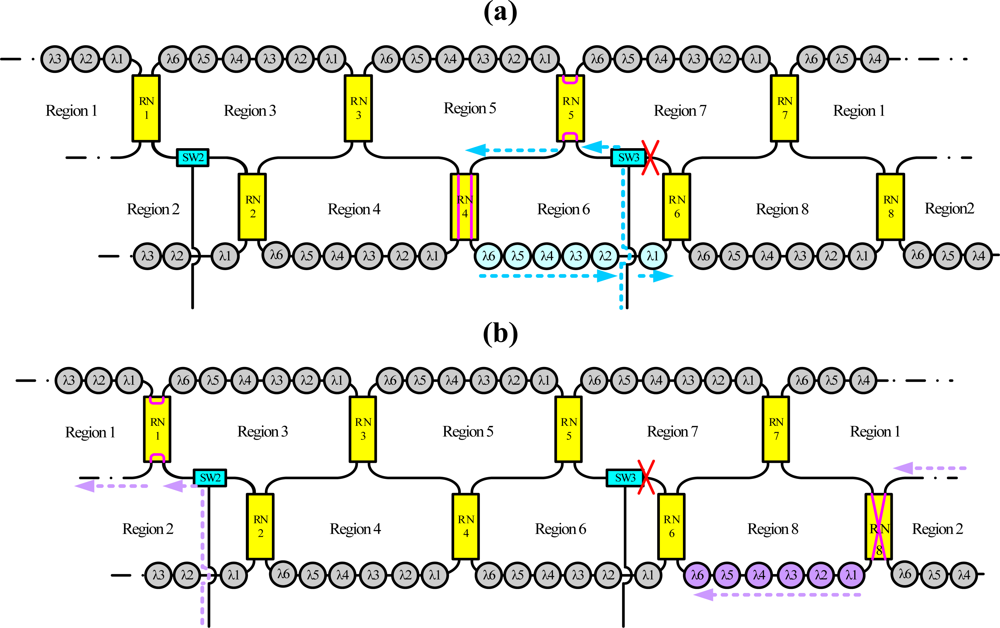Reliable Fiber Sensor System with Star-Ring-Bus Architecture
Abstract
:1. Introduction
2. Architecture
3. Experimental Results
4. Conclusions
Acknowledgments
References and Notes
- Yin, S.; Ruffin, P.B.; Yu, F.T.Y. (Eds.) Fiber Optic Sensors, 2nd ed; CRC Press: Boca Raton, FL, USA, 2008.
- Majumder, M.; Gangopadhyay, T.K.; Chakraborty, A.K.; Dasgupta, K.; Bhattacharya, D.K. Review Fibre Bragg Gratings in Structural Health Monitoring—Present Status and Applications. Sens. Actuat. A 2008, 147, 150–164. [Google Scholar]
- Kersey, A.D.; Davis, M.A.; Patrick, H.J.; LeBlanc, M.; Koo, K.P.; Askins, C.G.; Putnam, M.A.; Friebele, E.J. Fiber Grating Sensors. J. Lightwave Technol 1997, 15, 1442–1463. [Google Scholar]
- Lindner, E.; Chojetztki, C.; Brueckner, S.; Becker, M.; Rothhardt, M.; Vlekken, J.; Bartelt, H. Arrays of Regenerated Fiber Bragg Gratings in Non-Hydrogen-Loaded Photosensitive Fibers for High-Temperature Sensor Networks. Sensors 2009, 9, 8377–8381. [Google Scholar]
- Canning, J.; Stevenson, M.; Bandyopadhyay, S.; Cook, K. Extreme Silica Optical Fibre Gratings. Sensors 2008, 8, 6448–6452. [Google Scholar]
- Tsuda, H.; Urabe, K. Characterization of Long-Period Grating Refractive Index Sensors and Their Applications. Sensors 2009, 9, 4559–4571. [Google Scholar]
- Campopiano, S.; Cutolo, A.; Cusano, A.; Giordano, M.; Parente, G.; Lanza, G.; Laudati, A. Underwater Acoustic Sensors Based on Fiber Bragg Gratings. Sensors 2009, 9, 4446–4454. [Google Scholar]
- Yu, Y.; Lui, L.; Tam, H.; Chung, W. Fiber-Laser-Based Wavelength-Division Multiplexed Fiber Bragg Grating Sensor System. IEEE Photon. Technol. Lett 2001, 13, 702–704. [Google Scholar]
- Chan, C.C.; Jin, W.; Ho, H.L.; Demokan, M.S. Performance Analysis of a Time-Division-Multiplexed Fiber Bragg Grating Sensor Array by Use of a Tunable Laser Source. IEEE J. Select. Top. Quantum Electron 2000, 6, 741–749. [Google Scholar]
- Koo, K.P.; Tveten, A.B.; Vohra, S.T. Dense Wavelength Division Multiplexing of Fiber Bragg Grating Sensors Using CDMA. Electron. Lett 1999, 35, 165–167. [Google Scholar]
- Zhang, L.; Liu, Y.; Wiliams, J.A.R.; Bennion, I. Enhanced FBG Strain Sensing Multiplexing Capacity Using Combination of Intensity and Wavelength Dual-Coding Technique. IEEE Photon. Technol. Lett 1999, 11, 1638–1641. [Google Scholar]
- Chan, P.K.C.; Jin, W.; Demokan, M.S. FMCW Multiplexing of Fiber Bragg Grating Sensors. IEEE J. Select. Top. Quantum Electron 2000, 6, 756–763. [Google Scholar]
- Kister, G.; Winter, D.; Gebremichael, Y.; Leighton, J.; Badcock, R.A.; Tester, P.D.; Krishnamurthy, S.; Boyle, W.J.O.; Grattan, K.T.V.; Fernando, G.F. Methodology and Integrity Monitoring of Foundation Concrete Piles Using Bragg Grating Optical Fibre Sensors. Eng. Struct 2007, 29, 2048–2055. [Google Scholar]
- Li, H.N.; Li, D.S.; Song, G.B. Recent Applications of Fiber Optic Sensors to Health Monitoring in Civil Engineering. Eng. Struct 2004, 26, 1647–1657. [Google Scholar]
- Diaz, S.; Cerrolaza, B.; Lasheras, G.; Lopez-Amo, M. Double Raman Amplified Bus Networks for Wavelength-Division Multiplexing of Fiber-Optic Sensors. J. Lightwave Technol 2007, 25, 733–739. [Google Scholar]
- Montalvo, J.; Vázquez, C.; Montero, D.S. CWDM Self-Referencing Sensor Network Based on Ring Resonators in Reflective Configuration. Opt. Expr 2006, 14, 4601–4610. [Google Scholar]
- Talaverano, L.; Abad, S.; Jarabo, S.; Lopez-Amo, M. Multiwavelength Fiber Laser Sources with Bragg-Grating Sensor Multiplexing Capability. J. Lightwave Technol 2001, 19, 553–558. [Google Scholar]
- Vallejo, M.F.; Perez-Herrera, R.A.; Elosua, C.; Diaz, S.; Urquhart, P.; Bariain, C.; Lopez-Amo, M. Resilient Amplified Double-Ring Optical Networks to Multiplex Optical Fiber Sensors. J. Lightwave Technol 2009, 27, 1301–1306. [Google Scholar]
- Peng, P.C.; Feng, K.M.; Peng, W.R.; Chiou, H.Y.; Chang, C.C.; Chi, S. Long-Distance Fiber Grating Sensor System using a Fiber Ring Laser with EDWA and SOA. Opt. Commun 2005, 252, 127–131. [Google Scholar]
- Peng, P.C.; Tseng, H.Y.; Chi, S. Long-Distance FBG Sensor System Using a Linear-Cavity Fiber Raman Laser Scheme. IEEE Photon. Technol. Lett 2004, 16, 575–577. [Google Scholar]
- Peng, P.C.; Lin, J.H.; Tseng, H.Y.; Chi, S. Intensity and Wavelength Division Multiplexing FBG Sensor System Using a Tunable Multiport Fiber Ring Laser. IEEE Photon. Technol. Lett 2004, 16, 230–232. [Google Scholar]
- Fibera Inc. Athermal Fiber Bragg Grating Strain Sensor (FRMS 12250). 2010. Available online: http://www.fiberainc.com/frms.pdf (accessed on 22 April 2010).













© 2010 by the authors; licensee MDPI, Basel, Switzerland. This article is an open-access article distributed under the terms and conditions of the Creative Commons Attribution license ( http://creativecommons.org/licenses/by/3.0/).
Share and Cite
Peng, P.-C.; Wang, J.-B.; Huang, K.-Y. Reliable Fiber Sensor System with Star-Ring-Bus Architecture. Sensors 2010, 10, 4194-4205. https://doi.org/10.3390/s100504194
Peng P-C, Wang J-B, Huang K-Y. Reliable Fiber Sensor System with Star-Ring-Bus Architecture. Sensors. 2010; 10(5):4194-4205. https://doi.org/10.3390/s100504194
Chicago/Turabian StylePeng, Peng-Chun, Jun-Bo Wang, and Kuan-Yan Huang. 2010. "Reliable Fiber Sensor System with Star-Ring-Bus Architecture" Sensors 10, no. 5: 4194-4205. https://doi.org/10.3390/s100504194
APA StylePeng, P.-C., Wang, J.-B., & Huang, K.-Y. (2010). Reliable Fiber Sensor System with Star-Ring-Bus Architecture. Sensors, 10(5), 4194-4205. https://doi.org/10.3390/s100504194




